Lion850
National Hazard
   
Posts: 514
Registered: 7-10-2019
Location: Australia
Member Is Offline
Mood: Great
|
|
Attempt to make mercury iodide in hydrochloric acid
Having seen the reactions between iodine and gallium in HCl and iodine and tin in HCl I was keen to see if other metals, that usually don't react with
HCl, would react with iodine in an HCl medium.
- 4.7g mercury was placed in a evaporating dish and covered with 12ml concentrated hydrochloric acid. As expected, nothing happened.
- A few crystals of iodine was then added. The iodine started to dissolve in the acid, but no immediate reaction with the mercury.
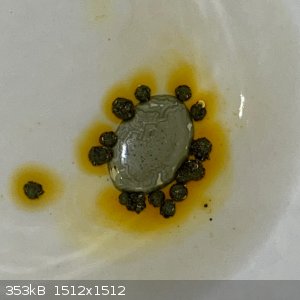
- After watching for some 10 minutes the rest of the iodine was added, in total 4g which should have kept the mercury in excess.
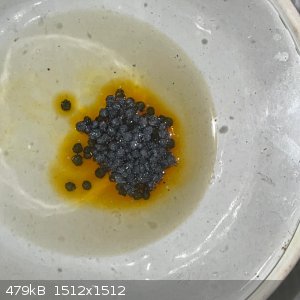
- After 2 days, the surface of the mercury was red and the mercury separated into 3 bits and was "flatter". Was the surface tension changed? But there
was still a lot of unreacted iodine.
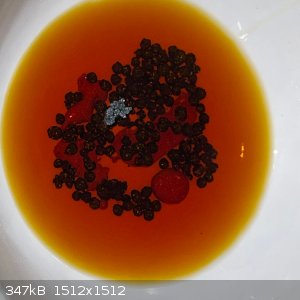
- After a further 3 days there was now some fine material but still a lot of unreacted iodine and mercury. I wondered whether a layer of HgI2 on the
mercury was slowing down the reaction. I transferred all to a small beaker, added another 10ml HCl, and stirred for 12 hours. After this the
supernatant solution was clear and there was now a lot of brown fine material, plus red smudges.
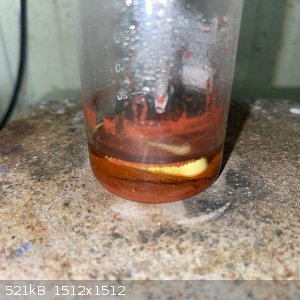
- I filtered the solution and washed the remainder with lots of cold water. The filtrate was clear, and I was left with a brown-ish powder with still
some unreacted iodine.
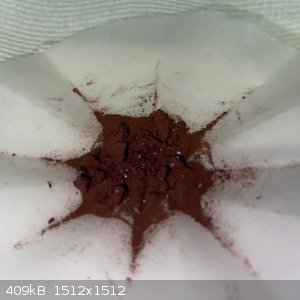
- The unreacted iodine and apparent lack of metallic mercury surprised me as I thought it should be the other was around. This iodine was also not so
readily soluble in hydrochloric acid.
- I heated a small sample on a steam bath, a small amount of iodine fumes was driven off and some turned a bit yellow.
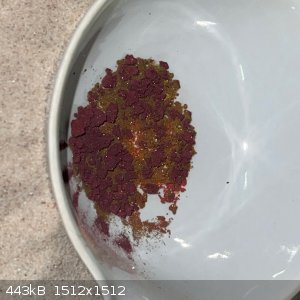
- I then heated it at around 200C on a sand bath. I did not hang around as I was not sure how much would escape, but when I returned some 30 minutes
later the lid on my sand bath pot was a nice yellow!
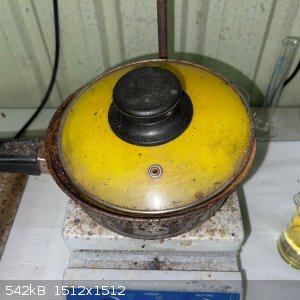
- And the contents of the evaporating dish was now red!
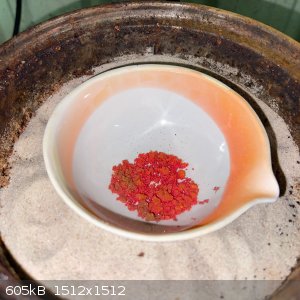
So, I think I have shown that mercury iodide can be made by direct contact between the elements at room temperature, in a hydrochloric acid solution,
followed by heating on a sand bath. I don't know how pure the final product is, but it seems to show the correct colors. But, did the main part of the
reaction happen in the acid, or was my initial predominantly brown product a fine mix of iodine and mercury that then reacted on the sand bath?
I'll be interested to hear your thoughts.
Edit: After cooling, the lid is still yellow, and the contents of the evaporating dish is now a pale orange in color.
[Edited on 13-4-2022 by Lion850]
|
|
|
njl
National Hazard
   
Posts: 609
Registered: 26-11-2019
Location: under the sycamore tree
Member Is Offline
Mood: ambivalent
|
|
You may have formed the monoiodide (Hg2I2) which would account for the missing excess of mercury.
Reflux condenser?? I barely know her!
|
|
|
Texium
Administrator
       
Posts: 4508
Registered: 11-1-2014
Location: Salt Lake City
Member Is Online
Mood: PhD candidate!
|
|
What is your yield?
|
|
|
Tsjerk
International Hazard
    
Posts: 3022
Registered: 20-4-2005
Location: Netherlands
Member Is Offline
Mood: Mood
|
|
Mercury does react with hydrochloric acid and oxygen, like copper does. I once left a couple grams of mercury in some hydrochloric acid to find nice
white crystals of HgCl2 without any mercury left.
So I expect a part of the HgI2 to be HgCl2.
[Edited on 14-4-2022 by Tsjerk]
|
|
|
Lion850
National Hazard
   
Posts: 514
Registered: 7-10-2019
Location: Australia
Member Is Offline
Mood: Great
|
|
Texium - 5.6g of dry product recovered. It's now the next day and the color has settled on a pale orange. The lid color did not change, it is still
yellow.
|
|
|
Tsjerk
International Hazard
    
Posts: 3022
Registered: 20-4-2005
Location: Netherlands
Member Is Offline
Mood: Mood
|
|
Is there a reason to think you need HCl in this preparation? Why wouldn't plain water or better DCM suffice?
|
|
|
Lion850
National Hazard
   
Posts: 514
Registered: 7-10-2019
Location: Australia
Member Is Offline
Mood: Great
|
|
Tsjerk - certainly worth trying water and DCM in future.
|
|
|
woelen
Super Administrator
        
Posts: 7976
Registered: 20-8-2005
Location: Netherlands
Member Is Offline
Mood: interested
|
|
I think that this reaction also can be done in water, and even better in a solvent, in which iodine dissolves more easily.
The color of the mercury iodide looks right, although it has some impurity (the brown stuff). Hg2I2 is dark yellow/brown, but quite unstable. I never
managed to make a pure compound, when I mix a solution of mercury(I) nitrate with a solution of potassium iodide, then a dirty looking dark
precipitate is formed, with a greenish/brown hue which most likely is Hg2I2, mixed with very finely divided elemental Hg and HgI2.
Hot HgI2 is bright yellow, but on cooling down, even slight mechanical agitation makes it scarlet again (or orange if it is very finely divided). If
you still have the yellow material on the lid, then try scraping this off off and see whether the scraping causes the material to turn orange.
|
|
|
zed
International Hazard
    
Posts: 2277
Registered: 6-9-2008
Location: Great State of Jefferson, City of Portland
Member Is Offline
Mood: Semi-repentant Sith Lord
|
|
Hmmm. On occasion, Mercuric Chloride is useful.
I had been under the impression, that it could only conveniently be produced via Mercuric Nitrate.
So, Mercury treated directly with Concentrated HCl, over time, will be converted to Mercuric Chloride?
|
|
|
Tsjerk
International Hazard
    
Posts: 3022
Registered: 20-4-2005
Location: Netherlands
Member Is Offline
Mood: Mood
|
|
Quote: Originally posted by zed  | Hmmm. On occasion, Mercuric Chloride is useful.
I had been under the impression, that it could only conveniently be produced via Mercuric Nitrate.
So, Mercury treated directly with Concentrated HCl, over time, will be converted to Mercuric Chloride? |
Yes, the reduction potential of oxygen and H+ is around 1.23 volt, which is enough to oxidize mercury, and it will do so over time. I don't know how
fast the mercury in my forgotten sample reacted, but after a couple of months there were only white crystals left.
|
|
|
zed
International Hazard
    
Posts: 2277
Registered: 6-9-2008
Location: Great State of Jefferson, City of Portland
Member Is Offline
Mood: Semi-repentant Sith Lord
|
|
I didn't know that. Thank you.
|
|
|
woelen
Super Administrator
        
Posts: 7976
Registered: 20-8-2005
Location: Netherlands
Member Is Offline
Mood: interested
|
|
Quote: Originally posted by Tsjerk  |
Yes, the reduction potential of oxygen and H+ is around 1.23 volt, which is enough to oxidize mercury, and it will do so over time. I don't know how
fast the mercury in my forgotten sample reacted, but after a couple of months there were only white crystals left. |
Interesting observation. I assume it was not tightly sealed (in order to allow any H2-gas to escape without pressure buildup). In
that case, there may also be oxidation by oxygen from the air.
Copper does not dissolve in hydrochloric acid, but when air is allowed in as well, then it does dissolve. This may also be the case for mercury. At
high concentrations of HCl, it also helps that complex ions CuCl4(2-) and HgCl4(2-) can be formed. This makes oxidation of the metal energetically
more favorable.
|
|
|
Tsjerk
International Hazard
    
Posts: 3022
Registered: 20-4-2005
Location: Netherlands
Member Is Offline
Mood: Mood
|
|
Quote: Originally posted by woelen  | Interesting observation. I assume it was not tightly sealed (in order to allow any H2-gas to escape without pressure buildup). In that case, there may
also be oxidation by oxygen from the air.
Copper does not dissolve in hydrochloric acid, but when air is allowed in as well, then it does dissolve. This may also be the case for mercury. At
high concentrations of HCl, it also helps that complex ions CuCl4(2-) and HgCl4(2-) can be formed. This makes oxidation of the metal energetically
more favorable. |
Yes, the mercury was definitely oxidized by oxygen, the reaction was in a small open beaker.
Mercury is more "noble" than copper is, so it can't have been only H+ that oxidized the mercury. The reduction potential of mercury is even higher
than that of silver. But oxygen and acid together are a very strong oxidizer. The reduction potential of 1.23 volt is close to that of acidified
dichromate.
Edit: Wait, I only realize now that without oxygen this is not going to work. Iodine is not a strong enough oxidizer to react with mercury. The
reduction potential of iodine is 0.54 volt, while mercury is 0.85. Bromine would react, but not iodine. So you would have to use HI with oxygen to
make HgI2 I suppose?
[Edited on 17-4-2022 by Tsjerk]
|
|
|
Tsjerk
International Hazard
    
Posts: 3022
Registered: 20-4-2005
Location: Netherlands
Member Is Offline
Mood: Mood
|
|
I found the picture I took back then. This is the mercury chloride formed by the action of hydrochloric acid and oxygen on mercury.
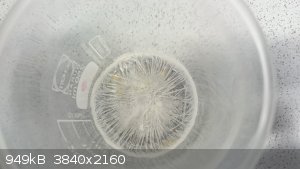
|
|
|